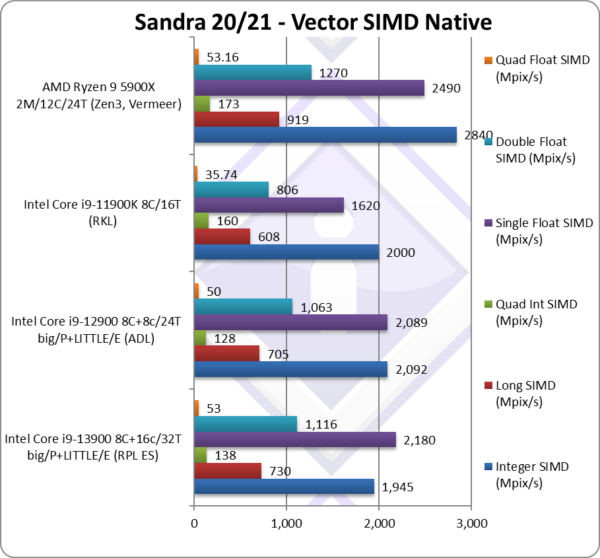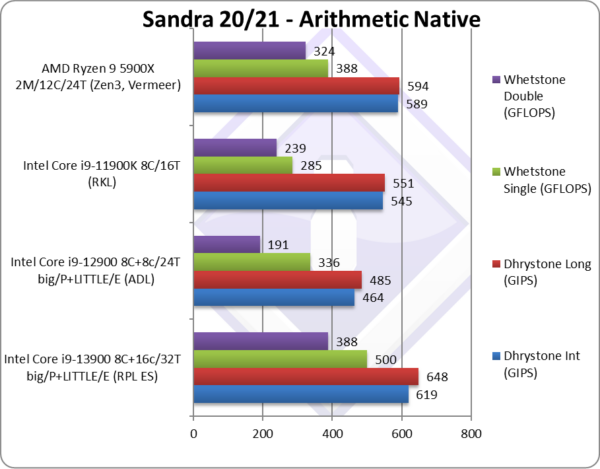Intel Raptor Lake Breaks Sweat in Preview Benchmarks
Multithreading monster vs 5900X
A set of benchmarks have appeared online for what appears to be Intel’s 13th-generation Core architecture, known as Raptor Lake, which will soon vie for a spot on our list of best gaming CPUs. The results, which appear to be from a submission to the SiSoftware database, appear to show the chip’s hybrid architecture gives a Ryzen 9 5900X a run for its money, though there are no direct apples-to-apples comparisons to be made between the chips chosen due to differing core counts. Also, these chips will face off with AMD's Ryzen 7000, which isn't on the market yet. Take the news more as an indication of what to expect, rather than solid fact until official benchmarks can be verified.
| Specifications | Intel Core i9-13900 8C+16c/32T (RPL) | Intel Core i9-12900 8C+8c/24T (ADL) | Intel Core i9-11900K 8C/16T (RKL) | AMD Ryzen 9 5900X 12C/24T (Zen3) |
|---|---|---|---|---|
| Architecture | Raptor Cove + Gracemont / RaptorLake | Golden Cove + Gracemont / AlderLake | Cypress Cove / RocketLake | Zen3 / Vermeer |
| Cores / Threads | 8C+16c / 32T | 8C+8c / 24T | 8C / 16T | 2M / 12C / 24T |
| Rated Speed (GHz) | ? | 2.4 big / 1.8 LITTLE | 3.5 | 3.7 |
| All/Single Turbo Speed (GHz) | 3.7 big / 2.76 LITTLE | 5.0 big / 3.8 LITTLE | 4.8 - 5.3 | 4.5 - 4.8 |
| Rated/Turbo Power (W) | 65 - 200 [=] | 65 - 200 | 125 - 228 | 105 - 135 |
| L1D / L1I Caches | 8x 48kB/32kB + 16x 64kB/32kB | 8x 48kB/32kB + 8x 64kB/32kB | 8x 48kB 12-way / 8x 32kB 8-way | 12x 32kB 8-way / 12x 32kB 8-way |
| L2 Caches | 8x 2MB + 4x 4MB (32MB) [+2.3x] | 8x 1.25MB + 2x 2MB (14MB) | 8x 512kB 16-way (4MB) | 12x 512kB 16-way (6MB) |
| L3 Cache(s) | 36MB 16-way [+20%] | 30MB 16-way | 16MB 16-way | 2x 32MB 16-way (64MB) |
| Microcode (Firmware) | TBA | 090672-1E | 06A701-40 | 8F7100-1009 |
| Special Instruction Sets | VNNI/256, SHA, VAES/256 | VNNI/256, SHA, VAES/256 | AVX512, VNNI/512, SHA, VAES/512 | AVX2/FMA, SHA |
| SIMD Width / Units | 2 x 256-bit | 2x 256-bit | 512-bit (1x FMA) | 2x 256-bit |
| Price / RRP (USD) | $549? | $519 | $539 | $549 |
The benchmarks use the 5900X - a 12-core, 24-thread chip - alongside Intel’s 11th and 12th-gen i9s, one an 8C/16T and the other a 16C(8+8)/24T hybrid design. The Raptor Lake contestant has more of the efficiency cores than the 12th-gen CPU, boasting eight power and 16 efficiency cores, for 32 threads overall and likely the same chip that leaked earlier this year.


Little wonder, then, that it comes out in front. The interpretation of the numbers is also kind to the Raptor Lake chip: “With non-SIMD code, we see huge performance uplift in both integer (old’ Dhrystone) and floating-point (old’ Whetstone) of 33% to 100% over ADL [Alder Lake] that help push (way) past even AMD’s Zen3 with 12 big cores! The extra eight Little Atom cores greatly help here.
“Thus for normal, non-SIMD code – RPL [Raptor Lake] will perform greatly and provide a great upgrade over ADL.”
This looks good for gaming, but is not the full story, as the second set of results, using vectorized SIMD code, show. Raptor Lake comes in second to Zen3 in three out of four tests: “With heavily vectorized SIMD workloads RPL cannot beat ADL by more than 4-6% and thus generally even lose to the AVX512-enabled RKL [Rocket Lake] with just 16 threads (vs. 32T on RPL). This shows just how much AVX512 can help despite the extra power required – and here it is hugely missed. However, AMD’s Zen3 (5900X) with [fewer] threads (24T) but 12 big cores (vs. 8C + 16c) still beats RPL by a decent margin.”
The ‘decent margin’ here being almost 900 points in the Integer SIMD test, which sees the 13th-gen Intel chip come last in the comparison.
The preview of the new chips and its conclusion are worth reading, bringing together threads such as software support for hybrid architectures, the effect of cache levels on performance, and whether Socket 1700 PCs are worth upgrading to, given that Meteor Lake will use a different interface. Otherwise, Intel’s 13th-generation Raptor Lake architecture seems like the multi-threading monster we were promised, but only when fed the right type of code. In the end, we won't know how the chip truly stacks up until we can test them ourselves for the CPU benchmark hierarchy.
Get Tom's Hardware's best news and in-depth reviews, straight to your inbox.

Ian Evenden is a UK-based news writer for Tom’s Hardware US. He’ll write about anything, but stories about Raspberry Pi and DIY robots seem to find their way to him.
-
-Fran- Hm... Is it me or these leaks are just saying "Raptor Lake is just a small bump over Alder Lake"? Am I interpreting this correctly? Sure they tout some "30 to 100% bumps in some very specific scenarios", but those we all know what they actually mean.Reply
Also, the 5900X is nowhere near its MSRP now. You can always find it at or under ~$420 (£360 in the UK). We have Alder Lake to thank for that!
To me, this is just small confirmation Meteor Lake will be trading blows with Zen4. Which is good.
Regards. -
hotaru251 Reply
if it can barely beat 5900 (not even best in productivity or gaming as thats 5950x & 5800x3d) i doubt it'll trade blows with Zen 4's high end unless they can get a lot more performance from now until release.-Fran- said:this is just small confirmation Meteor Lake will be trading blows with Zen4.
not super exciting to see a 13900 (basically the flagship) only beat it by a small amount and they also get crushed in vector vs not flagship previous gen.
Also have to remember its (likely) ddr 5 vs ddr4 in the benchmarks (as zen3 doesnt use ddr5)
Hope they can get better performance thoguh as want competition. -
-Fran- Reply
Look at the purported clocks and also assume this is an ES. The very limited information we can go by and filling the blanks/gaps with some good guesses, make me think Meteor Lake won't be a second Alder Lake in terms of improvement, but in MP it'll be decent enough. Those extra cores will help for sure. How much? Well, it'll depend on final clocks. I think they're using the same Silvermont lil' cores for Raptor, no?hotaru251 said:if it can barely beat 5900 (not even best in productivity or gaming as thats 5950x & 5800x3d) i doubt it'll trade blows with Zen 4's high end unless they can get a lot more performance from now until release.
not super exciting to see a 13900 (basically the flagship) only beat it by a small amount and they also get crushed in vector vs not flagship previous gen.
Also have to remember its (likely) ddr 5 vs ddr4 in the benchmarks (as zen3 doesnt use ddr5)
Hope they can get better performance thoguh as want competition.
Regards. -
criticaloftom there's only really one worthwhile metric 'performance per dollar @ same tdp'.Reply
If you can't provide it; then all you've got is hot air & supposition. -
TerryLaze Reply
Yes, thank God there is only one software out there so measuring this is super easy and convenient for everybody.criticaloftom said:there's only really one worthwhile metric 'performance per dollar @ same tdp'.
If you can't provide it; then all you've got is hot air & supposition. -
shady28 Keep in mind this 13900 ES part is running 26% slower clocks than the 12900 it's being compared to. I can't imagine it would come out at 3.7Ghz, that's not going to happen.Reply
That said I didn't expect anything more than a few % in IPC from Raptor Lake vs Alder. The boost was always going to be in additional cores and some cache rework - L1 and L3 look like they are the same just more cores, L2 though is different. The DDR5 memory controller should be improved as well. -
TerryLaze Reply
That's what it's reporting...shady28 said:Keep in mind this 13900 ES part is running 26% slower clocks than the 12900 it's being compared to. I can't imagine it would come out at 3.7Ghz, that's not going to happen.
but we all know how badly ES or new CPU support in general is for the apps that read out this info.
We can hope that it was really running at that speed because that would mean that the end product would be very nice but it's not a sure thing.
